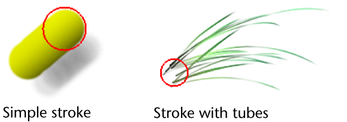Paint on the canvas
When you display the Paint Effects canvas, the Paint Effects Tool is selected automatically. The cursor shows the width of the stroke path. For simple strokes, the brush width defines the paint stamp. For strokes with tubes, the brush width defines the stroke path boundary—tubes can start growing only within the path defined by the brush width.

To paint brush strokes on the canvas
 ). You
can map up to three brush attributes to the stylus pressure. For
information on modifying stylus pressure mappings, see
Make the brush respond to stylus pressure.
). You
can map up to three brush attributes to the stylus pressure. For
information on modifying stylus pressure mappings, see
Make the brush respond to stylus pressure.
If you do not select a preset brush, the next stroke you paint uses the current settings for the template brush.
There is only one level of undo—you can only undo the last stroke.